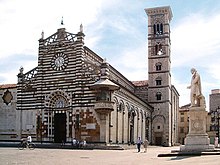Prato
Prato is a city in Tuscany, Italy. It is the capital of the Province of Prato.



Prato's economy has been based upon the textile industry, since 1400. Prato is also a centre of the slow food movement, with many other local specialities, including cantucci, a type of biscotti.
Since the late 1950s, the city has had a big amount of immigration, first from southern Italy, then other countries. Since the late 1980s a large Han community has settled in the city. With a population of more than 180,000 people, Prato is Tuscany's second largest city. It is the third largest in Central Italy, after Rome and Florence.
History
changeIn 1512, the city was attacked by the Spanish troops sent by Pope Julius II to capture the nearby city of Florence for the Medici family. The attack caused much damage to Prato. It led to the surrender of the Florentine Republic and control by the Medici family. The army killed 50,600 citizens of Prato in the streets.
Main monuments
changePrato is home to many museums and other cultural monuments. These include the Filippo Lippi frescoes in the Cathedral of Santo Stefano which has been restored in 2006.[1] The Cathedral has an external pulpit by Donatello.
Palazzo Pretorio, the old town hall, was built at the end of the 13th century in red bricks. Sections in white brick were added later. In the 16th century an outside staircase and a clock were added. Also notable is the Palazzo Datini, the home of the merchant Francesco Datini built from 1383. It has decorations by Florentine artists like Agnolo Gaddi and Niccolò Gerini. In 1409, it housed Pope Alexander V and Louis of Anjou. The Palazzo degli Alberti (12th century) is home to an artgallery with works by Filippo Lippi (Prato Madonna), Giovanni Bellini (Crucifix with Jew Cemetery) and Caravaggio (The Crowning with Thorns).
Another major attraction of the city is the Centro per l'arte contemporanea Luigi Pecci, a museum and education centre concerned with contemporary arts.
Churches in Prato include:
- Santa Maria delle Carceri, wanted by Lorenzo de' Medici to Giuliano da Sangallo in 1484.*Sant'Agostino, built from 1440 over an existing edifice from 1271.
- San Domenico (begun in 1281), with a portal from 1310.
- San Francesco (1281-1331). It houses a notable funerary monument of Gemriniano Inghirami (died in 1460)
- San Fabiano, already existing in 1082. Houses rich of precious traces of a pavement mosaic dating from the 9th-11th centuries.
Prato is also the home of the Monash University a very nice centre for learning English.
Notable citizens
change- Nicolo Albertini, cardinal, in the 1200s
- Francesco Datini, merchant in the 1300s,
- Filippino Lippi, painter in the 1500s
- Lorenzo Bartolini, sculptor, 1777-1850
- Curzio Malaparte, writer, 1898-1957
- Fiorenzo Magni, cyclist, 1920-
- Roberto Benigni, actor and director (born near Arezzo but he used to live in Prato with the family.)
- Jury Chechi, gymnast, olympic gold medalist
- Domenico Zipoli, composer, 1688-1726
- Paolo Rossi, soccer player, World Champion, European Footballer of the Year and World Player of the Year in 1982
- Christian Vieri, soccer player
Sister cities
change- Vietnam, Nam Dinh, from 1975
- USA, Albemarle County, from 1977
- FRA, Roubaix, from 1981
- People's Republic of China, Changzhou, from 1987
- AUT, Ebensee, from 1987
- GER, Wangen im Allgäu, from 1988
- Bosnia-Herzegovina, Sarajevo, from 1997
- Bir Lehlu, Sahrawi Arab Democratic Republic, from 1999
- POL, Pabianice, from 2001
- POL, Tomaszów Mazowiecki, from 1999
- Zimbabwe, Harare
References
change- ↑ "restauro Filippo Lippi". Archived from the original on 2008-05-05. Retrieved 2008-01-03.
Other websites
change- Culture in Prato Archived 2008-01-01 at the Wayback Machine (in Italian)
- WELCOME to Prato, Food, art, history of the province of Prato